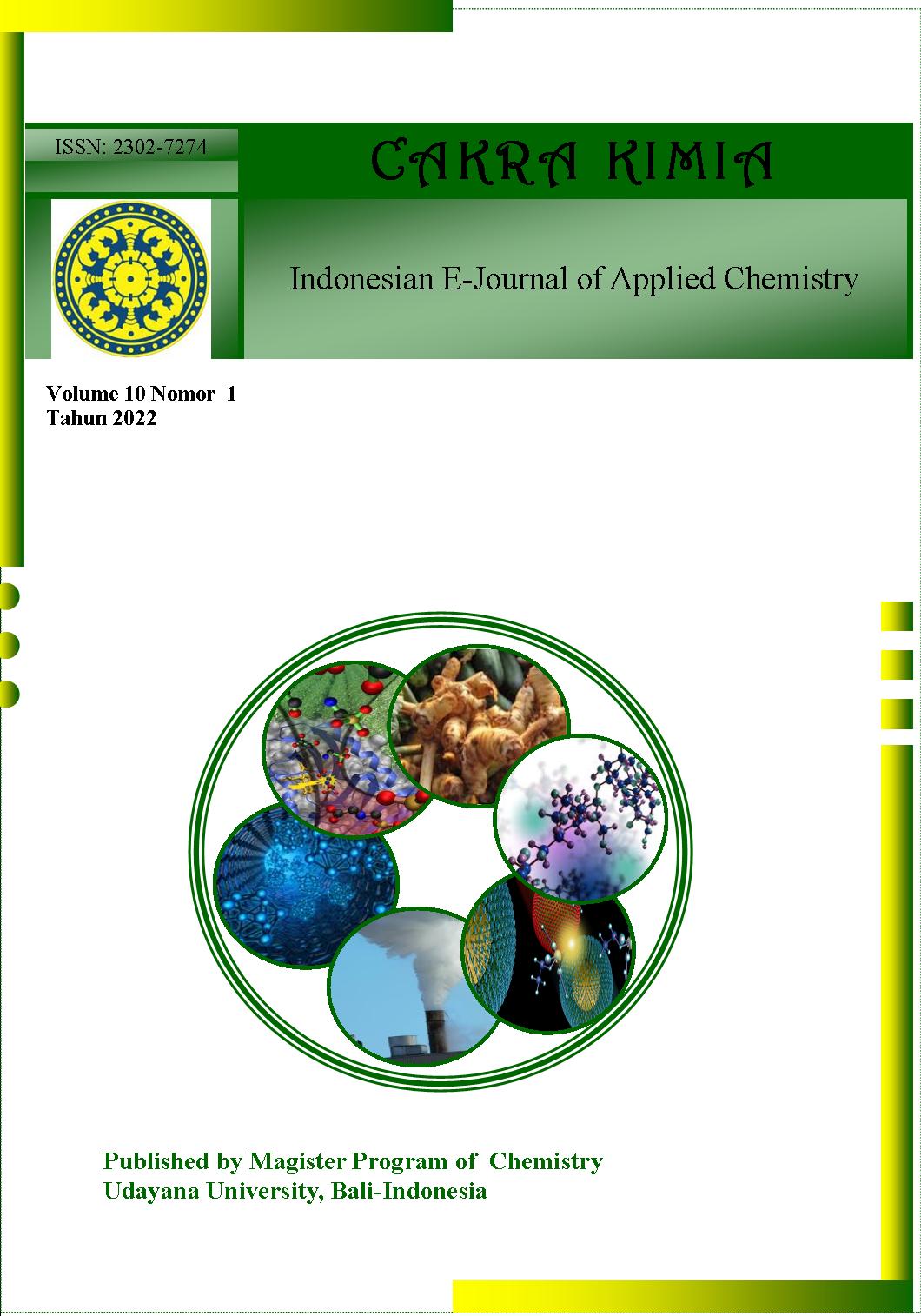PHYTOCHEMICAL SCREENING AND CHEMICAL COMPOTITION OF EUCALYPTUS LEAVES (Melaleuca leucadendron Linn) BY GC-MS
Abstract
ABSTRAK: Saat ini minat terhadap penggunaan tanaman aromatik di berbagai bidang kehidupan berdasarkan sifatnya makin meningkat. Oleh karena itu, pada penelitian ini akan dilakukan uji komposisi kimia daun kayu putih (Melalueca leucadendron Linn.) dari Pulau Lombok dengan menggunakan uji fitokimia dan teknik GC-MS (Gas Chromatography - Mass Spectrometry). Hasil uji fitokimia yang teridentifikasi adalah terpenoid, flavonoid, alkaloid, triterpenoid, tanin, dan saponin. Komposisi kimia dari daun kayu putih (Melalueca leucadendron Linn.) ditentukan oleh GC-MS dari ketiga fraksi yaitu etanol, DCM, dan heksana. Komposisi utama dalam ekstrak etanol adalah asam heksadekanoat (26,69%) dan asam heptadekana-8-karbonat (31,19%), pada DCM yaitu 1,8-cineole (2,31%), asam heksaadekanoik (25.88%), heptadecene-8-carbonic acid (28,75%) Sementara senyawa kimia utama yang ada pada heksana adalah 1,8-cineole (23,31%), 1-phellandren (1,33%), terpineol (1,16%), spathulenol (0,85%), ethanone (3,4-epoxy-2-heksanon) (0.72%), asam heksadekanoat (16,06%), dan heptadecene-8-carbonic acid (19,92%).
ABSTRACT : Recently, there has been increasing interest in the use of aromatic plants, which are used in the different areas of life based on various of the plant properties. The aim of this study was to investigate the chemical composition of Eucalyptus leaves (Melalueca leucadendron Linn.) from Lombok Island by phytochemical screening and GC-MS (Gas Chromatography - Mass Spectrometry) technique. The identified phytochemical screening of the leaves was terpenoid, flavonoid, alkaloid, triterpenoid, tannin and saponin. The chemical composition of the leaves was determined by GC-MS (Gas Chromatography - Mass Spectrometry) at three fractions, such as ethanol, DCM, and hexane. The major compounds in ethanol extract are hexadecanoic acid (26.69%) and heptadecene-8-carbonic acid (31,19%) while in the DCM are 1,8-cineole (2.31%), hexadecanoic acid (25.88%), heptadecene-8-carbonic acid (28.75%). Meanwhile, the major compounds in the hexane are 1,8-cineole (23.31%), 1-phellandren (1.33%), terpineol (1.16%), spathulenol (0.85%), ethanone (3,4-epoxy-2-heksanon) (0.72%), hexadecanoic acid (16.06%), and heptadecene-8-carbonic acid (19.92%).
Downloads
References
[2] Chahomchuen T, Insuan O, Insuan W. Chemical profile of leaf essential oils from four Eucalyptus species from Thailand and their biological activities. Microchem J. 2020; 158. https://doi.org/10.1016/j.microc.2020.105248
[3] Brophy JJ, Craven LA, Doran JC. Melaleucas: their botany, essential oils and uses. ACIAR Monogr. 2013; 156,415.
[4] Hashim AN, Swilam NF, Moustafa ES, Bakry SM, Labib RM, Barakat HH, et al. A cytotoxic flavonol glycoside from Melaleuca leucadendra leaves extract with immunostimulant activity. Pharmazie, 2018; 73(1), 61-64.
[5] Joen STN. Efektivitas ekstrak daun kayu putih (Melaleuca leucadendron L.) sebagai antibakteri secara in vitro. Majority. 2020; 9(2), 45-48.
[6] Bianchini Silva LS, Perasoli FB, Carvalho KV, Vieira KM, Paz Lopes MT, Bianco de Souza GH, et al. Melaleuca leucadendron (L.) L. flower extract exhibits antioxidant and photoprotective activities in human keratinocytes exposed to ultraviolet B radiation. Free Radic Biol Med. 2020; 159,54-65
[7] Palá-Paúl J, Pérez-Alonso MJ, Velasco-Negueruela A, Sanz J. Study of essential oils of Eucalyptus resinifera Smith, E. tereticornis Smith and Corymbia maculata (Hook.) K.D. Hill & L.A.S. Johnson, grown in Cuba. Flavour Fragr J. 2002; 17(1), 1-4.
[8] Harborne J. Metode Fitokimia. Penuntun Cara Modern Menganalisis Tumbuhan [Internet]. Penerbit ITB Bandung; 1987. 27 p. Available from: http://library.sith.itb.ac.id/%0Aindex.php?menu=library&action=detail&libraryID=5577.
[9] Yoshida T, Maruyama T, Nitta A, Okuda T. An hydrolysable tannin and accompanying polyphenols from Melaleuca leucadendron. Phytochemistry. 1996; 42(4), 1171-1173.
[10] Ghasemian A, Eslami M, Hasanvand F, Bozorgi H, Al-abodi HR. Eucalyptus camaldulensis properties for use in the eradication of infections. Comp Immunol Microbiol Infect Dis. 2019; 65, 234-237. DOI 10.1016/j.cimid.2019.04.007
[11] Ishnava KB, Chauhan JB, Barad MB. Anticariogenic and phytochemical evaluation of Eucalyptus globules Labill. Saudi J Biol Sci. 2013; 20(1), 69-74.DOI10.1016/j.sjbs.2012.11.003
[12] Chograni H, Riahi L, Dhahri S, Ezzine O, Chakroun H, Messaoud C. Interspecific variability of 1,8-cineole content, phenolics and bioactivity among nine Eucalyptus taxa growing under the sub-humid bioclimate stage. J Complement Integr Med. 2021; 14(4) DOI 10.1515/jcim-2019-0159.
[13] SHARMA AD, KAUR I. Molecular docking and pharmacokinetic screening of eucalyptol (1,8 cineole) from eucalyptus essential oil against SARS-CoV-2. Not Sci Biol. 2020; 536-545. DOI 10.15835/nsb12210711.
[14] Tine Y, Diallo A, Diop A, Costa J, Boye CSB, Wélé A, et al. The Essential oil of Eucalyptus alba L. Growing on the Salt Zone of Fatick (Senegal) as a Source of 1,8-Cineole and Their Antibacterial Activity. J Drug Deliv Ther. 2020; 10(1-2), 140-143. DOI 10.22270/jddt.v10i1-s.3918.
[15] Sefidkon F, Asareh MH, Abravesh Z, Kandi MNH. Seasonal variation in the essential oil and 1,8-cineole content of four eucalyptus species (E. intertexta, E. platypus, E. leucoxylon and E. camaldulensis). J Essent Oil-Bearing Plants. 2010; 13(5), 528-539. DOI10.1080/0972060X.2010.10643858.
[16] Achmad HN, Rana HE, Fadilla I, Fajar A, Manurung R, Abduh MY. Determination Of Yield and Chemical Composition of Eucalyptus Oil From Different Species and Locations in Indonesia. Biol Nat Resour Eng J. 2018; 01(01), 36-49.
[17] Dos Santos IB, Lopes M da S, Bini AP, Tschoeke BAP, Verssani BAW, Figueredo EF, et al. The Eucalyptus cuticular Waxes contribute in preformed defense against austropuccinia psidii. Front Plant Sci. 2019; 9. DOI 10.3389/fpls.2018.01978.
[18] Ali OT, Mohammed MJ. Isolation, characterization, and biological activity of some fatty acids and volatile oils from iraqi eucalyptus microtheca plant. Int J Pharm Qual Assur. 2020; 11(1), 138-143. DOI 10.25258/ijpqa.11.1.21.
[19] Elaieb MT, Ben Ayed S, Dumarçay S, De Freitas Homen De Faria B, Thévenon MF, Gérardin P, et al. Natural durability of four Tunisian Eucalyptus spp. And their respective compositions in extractives. Holzforschung. 2020; 74(3), 260-274. DOI 10.1515/hf-2019-0090.



 Petunjuk Penulisan
Petunjuk Penulisan
